Overall upwards movement was expected. The Elliott wave target remains the same.
Summary: The next target is at 3,120. Overall, expect upwards movement to continue.
If price breaks below the lower edge of the best fit channel on the hourly charts, that would indicate a short-term pullback may be underway. At that stage, a target for a pullback to end would be about 3,002.
The biggest picture, Grand Super Cycle analysis, is here.
Monthly charts were last published here, with video here. There are two further alternate monthly charts here, with video here.
ELLIOTT WAVE COUNTS
The two weekly Elliott wave counts below will be labelled First and Second. They may be about of even probability. When the fifth wave currently unfolding on weekly charts may be complete, then these two wave counts will diverge on the severity of the expected following bear market. To see an illustration of this future divergence monthly charts should be viewed.
FIRST WAVE COUNT
WEEKLY CHART
The basic Elliott wave structure consists of a five wave structure up followed by a three wave structure down (for a bull market). This wave count sees the bull market beginning in March 2009 as an incomplete five wave impulse and now within the last fifth wave, which is labelled cycle wave V. This impulse is best viewed on monthly charts. The weekly chart focusses on the end of it.
Elliott wave is fractal. This fifth wave labelled cycle wave V may end a larger fifth wave labelled Super Cycle wave (V), which may end a larger first wave labelled Grand Super Cycle wave I.
The teal Elliott channel is drawn using Elliott’s first technique about the impulse of Super Cycle wave (V). Draw the first trend line from the end of cycle wave I (off to the left of the chart, the weekly candlestick beginning 30th November 2014) to the end of cycle wave III, then place a parallel copy on the end of cycle wave II. This channel perfectly shows where cycle wave IV ended at support. The strongest portion of cycle wave III, the end of primary wave 3, overshoots the upper edge of the channel. This is a typical look for a third wave and suggests the channel is drawn correctly and the way the impulse is counted is correct.
Within Super Cycle wave (V), cycle wave III is shorter than cycle wave I. A core Elliott wave rule states that a third wave may never be the shortest. For this rule to be met in this instance, cycle wave V may not be longer in length than cycle wave III. This limit is at 3,477.39.
Cycle wave V may subdivide either as an impulse or an ending diagonal. Impulses are much more common. An alternate wave count, which looked at the possibility of a diagonal unfolding, has been invalidated with a new all time high.
The daily chart below will focus on movement from the end of intermediate wave (1) within primary wave 3.
In historic analysis, two further monthly charts have been published that do not have a limit to upwards movement and are more bullish than this wave count. Members are encouraged to consider those possibilities (links below summary) alongside the wave counts presented on a daily and weekly basis.
Within cycle wave V, primary waves 1 and 2 may be complete. Within primary wave 3, intermediate waves (1) and (2) may be complete. Within intermediate wave (3), no second wave correction may move beyond its start below 2,822.12.
DAILY CHART
Primary wave 3 may have begun.
All of primary wave 3, intermediate wave (3) and minor wave 3 may only subdivide as impulses. Within each impulse, its second wave correction may not move beyond the start of its first wave.
Minor wave 3 may be underway and may have passed through its middle (main hourly chart). Within minor wave 3, if minute wave ii is yet to unfold (alternate hourly chart below), then it may not move beyond the start of minute wave i below 2,855.96.
Intermediate wave (3) must move far enough above the end of intermediate wave (1) to then allow intermediate wave (4) to unfold and remain above intermediate wave (1) price territory.
HOURLY CHART
Minor wave 2 should be over.
There are multiple ways now to label upwards movement from the end of minor wave 2. It is possible that the middle of the third wave has passed, with weaker momentum than the first wave. The fifth wave may be weaker still so that the third wave is not the weakest.
Within minute wave iii, minuette wave (ii) may have completed as a double combination and now minuette wave (iv) may be complete as a quicker zigzag.
When minuette wave (v) may be complete, then the whole structure of minute wave iii may be complete at all degrees. A sideways consolidation or pullback to last one to four sessions may then begin for minute wave iv.
Minute wave iv may not move into minute wave i price territory below 3,003.28.
Prior to invalidation this wave count may be discarded or swapped over to an alternate if price breaks below the lower edge of the best fit channel.
ALTERNATE HOURLY CHART
Although price did make a new low below 3,027.39 and closed the gap of three sessions ago, a strong finish to the end of the session with price remaining within the best fit channel sees this wave count remain an alternate.
This labelling of upwards movement from the end of minor wave 2 better fits MACD. If minute wave i is complete, then the strongest middle portion of sub-micro wave (3) corresponds with the strongest momentum from MACD.
The channel is drawn as a best fit in the same way on both hourly charts. Minute wave ii may breach the channel.
Minute wave ii may end about the 0.236 or 0.146 Fibonacci ratio. Minute wave ii may not move beyond the start of minute wave i below 2,855.96. The upwards pull of a third wave at three degrees may force minute wave ii to be shallow.
Minute wave ii may be unfolding as a flat correction. Within minute wave ii, both minuette waves (a) and (b) subdivide as threes. Minuette wave (b) may be a 1.11 length of minuette wave (a), indicating an expanded flat. At 3,018 minuette wave (c) would reach 1.618 the length of minuette wave (a); this is close to the 0.146 Fibonacci ratio at 3,019.85, giving a small target zone.
SECOND WAVE COUNT
WEEKLY CHART
This weekly chart is almost identical to the first weekly chart, with the sole exception being the degree of labelling.
This weekly chart moves the degree of labelling for the impulse beginning in March 2009 all down one degree. This difference is best viewed on monthly charts.
The impulse is still viewed as nearing an end; a fifth wave is still seen as needing to complete higher. This wave count labels it primary wave 5.
Primary wave 5 may be subdividing as either an impulse, in the same way that cycle wave V is seen for the first weekly chart.
TECHNICAL ANALYSIS
WEEKLY CHART
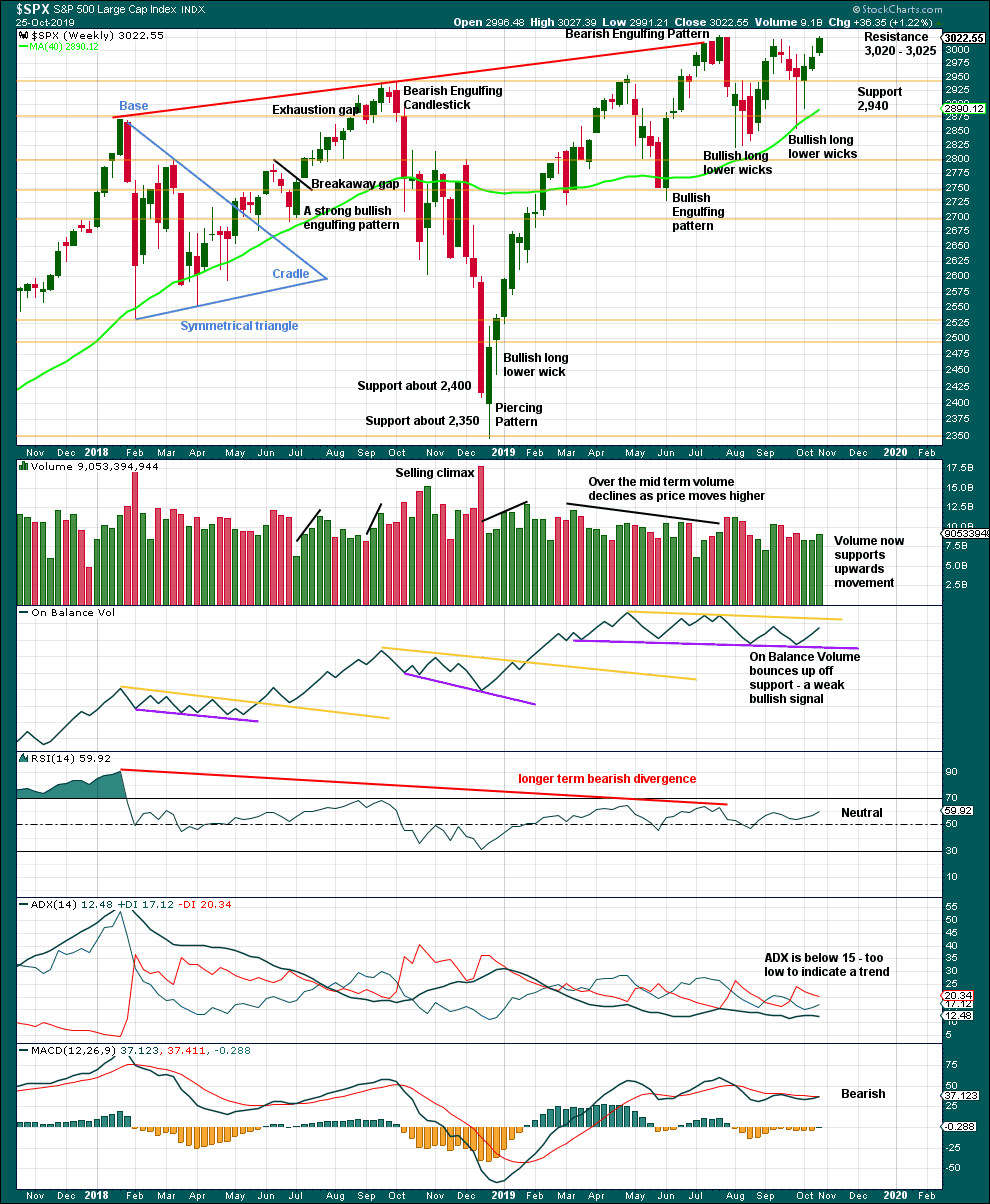
Click chart to enlarge. Chart courtesy of StockCharts.com.
There is still a series of higher highs (with the exception of the last high) and higher lows from the low in December 2018. This is the basic definition of an upwards trend. For that view to shift then a lower low below 2,822.12 would need to be seen.
Last week looks more clearly bullish with some support from volume. There is strong resistance which has been overcome.
DAILY CHART
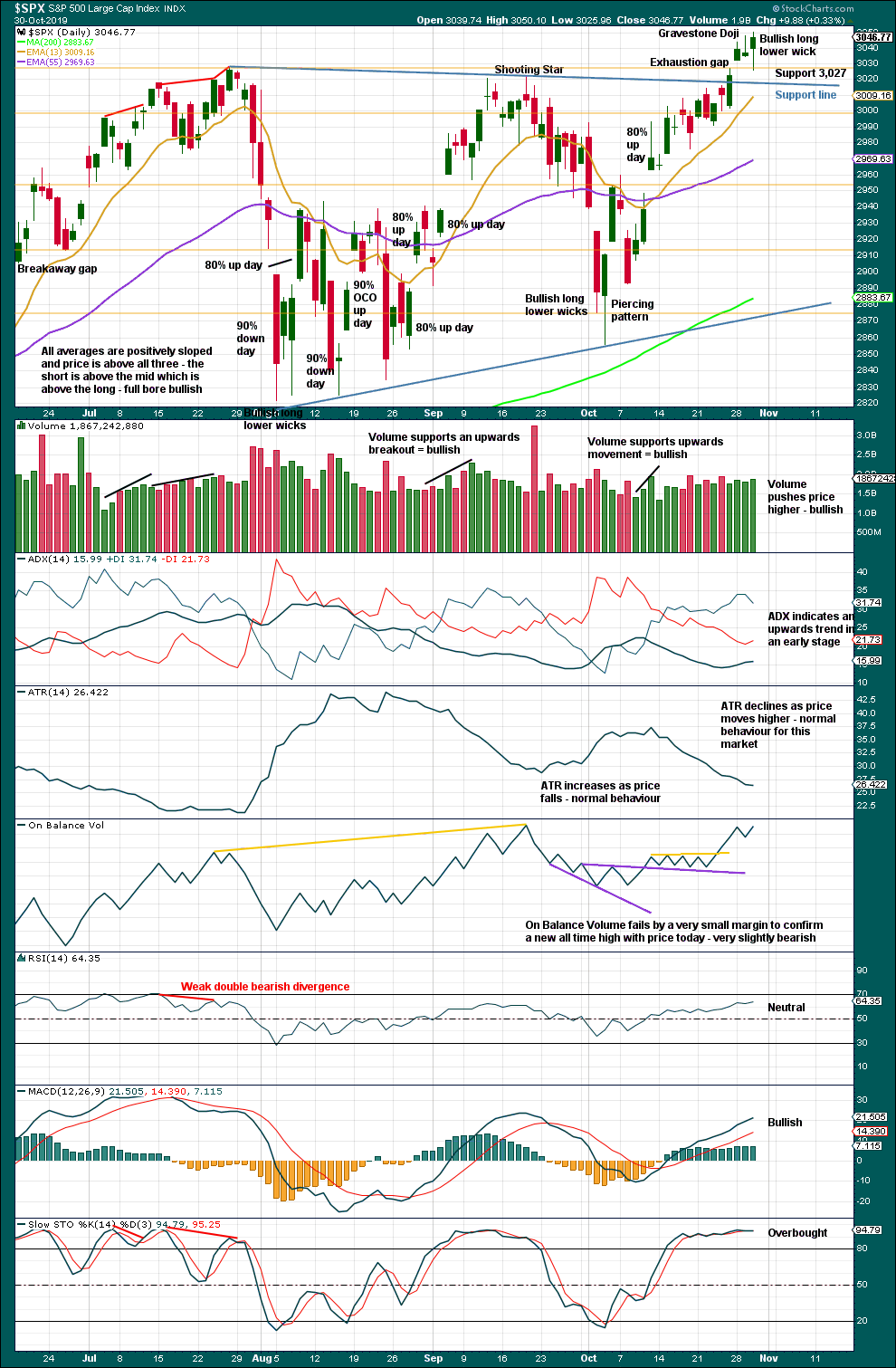
Click chart to enlarge. Chart courtesy of StockCharts.com.
There is now a series of higher highs and higher lows since the 5th of August. Strength in 90% up days and back to back 80% up days off lows indicate the lows may still be sustainable.
Volume for the breakout day shows some support for the breakout, so there is confidence in it.
Closure of the breakaway gap indicates it should now be considered an exhaustion gap. Along with yesterday’s Gravestone Doji, this is bearish.
However, a strong finish to this last session with a long lower wick strongly contradicts this bearishness.
There is some developing weakness: On Balance Volume today fails again by a very small margin to make a new all time high. There is risk of a pullback, but support may be expected at least initially in the area about 3,027.
BREADTH – AD LINE
WEEKLY CHART
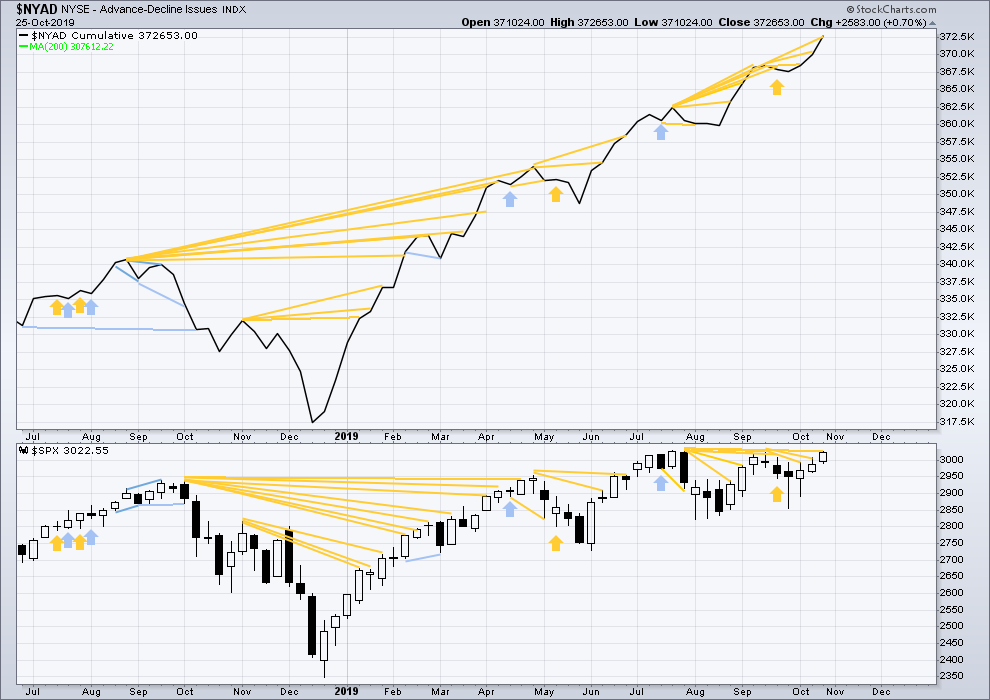
Click chart to enlarge. Chart courtesy of StockCharts.com. So that colour blind members are included, bearish signals
will be noted with blue and bullish signals with yellow.
Bear markets from the Great Depression and onwards have been preceded by an average minimum of 4 months divergence between price and the AD line with only two exceptions in 1946 and 1976. With the AD line making new all time highs again this week, the end of this bull market and the start of a new bear market is very likely a minimum of 4 months away, which is end February 2020.
In all bear markets in the last 90 years there is some positive correlation (0.6022) between the length of bearish divergence and the depth of the following bear market. No to little divergence is correlated with more shallow bear markets. Longer divergence is correlated with deeper bear markets.
If a bear market does develop here, it comes after no bearish divergence. It would therefore more likely be shallow.
Last week only large caps have made a new high above the prior swing high in mid September. Small and mid caps have not. This current rise is driven mostly by larger caps, which is a feature more typical of an aged bull market.
The new all time high from the AD line last week is again a very bullish signal. This strongly supports the main Elliott wave count.
DAILY CHART
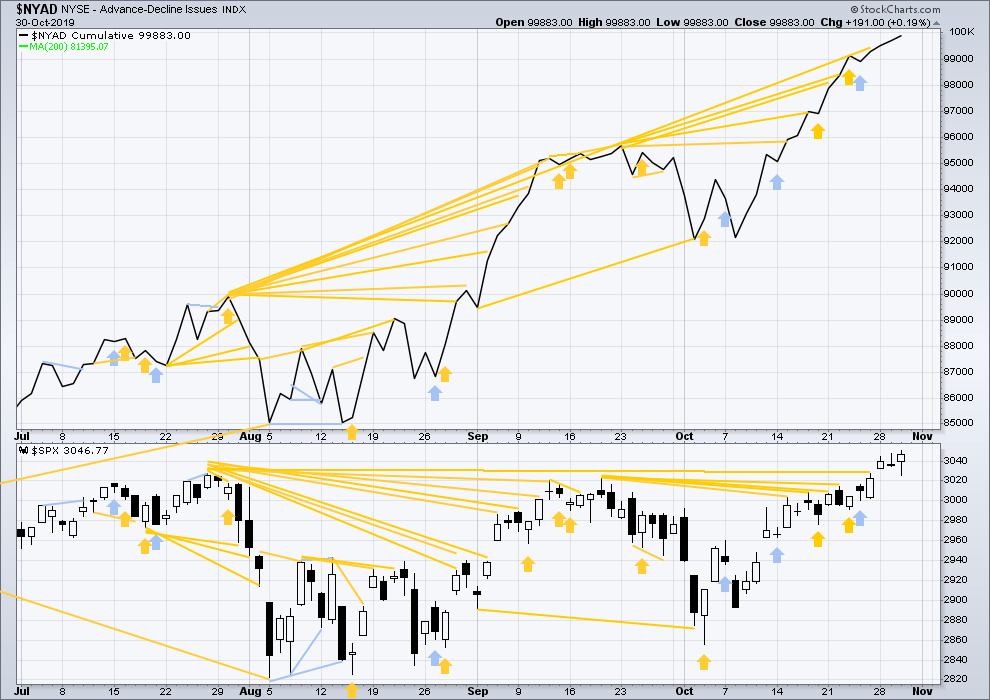
Click chart to enlarge. Chart courtesy of StockCharts.com. So that colour blind members are included, bearish signals
will be noted with blue and bullish signals with yellow.
Breadth should be read as a leading indicator.
The AD line makes yet another new all time high today. This divergence is bullish and strong. It is given reasonable weight in this analysis.
The new all time high from the AD line today confirms the new all time high from price.
VOLATILITY – INVERTED VIX CHART
WEEKLY CHART
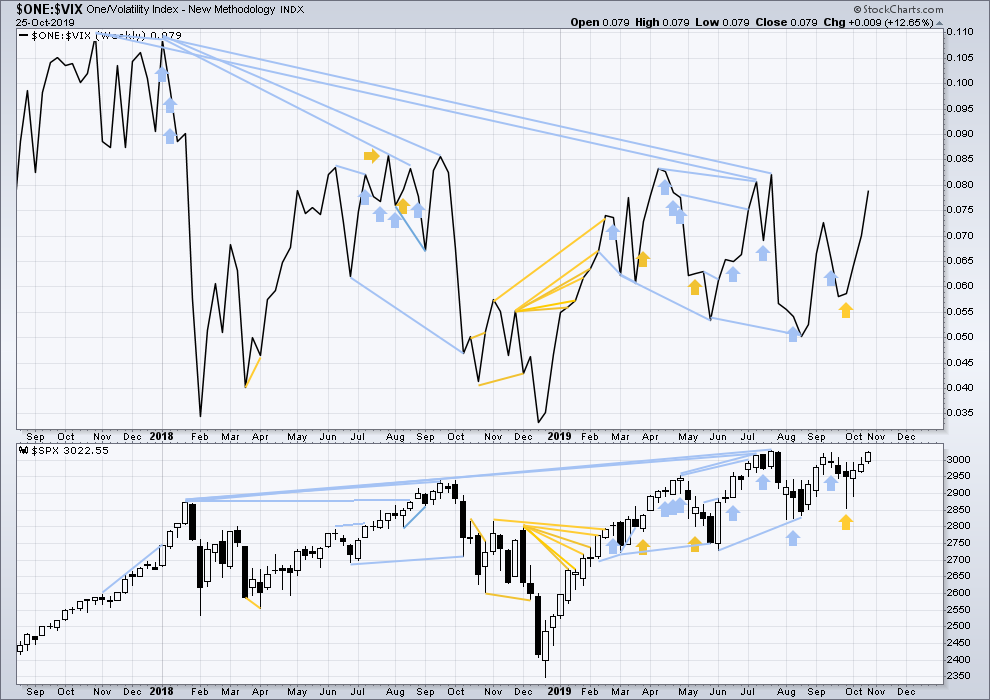
Click chart to enlarge. Chart courtesy of StockCharts.com. So that colour blind members are included, bearish signals
will be noted with blue and bullish signals with yellow.
The all time high for inverted VIX (which is the same as the low for VIX) was on 30th October 2017. There is now almost two years of bearish divergence between price and inverted VIX.
The rise in price is not coming with a normal corresponding decline in VIX; VIX remains elevated. This long-term divergence is bearish and may yet develop further as the bull market matures.
This divergence may be an early warning, a part of the process of a top developing that may take years. It may not be useful in timing a trend change.
Last week both price and inverted VIX have moved higher. Both have made new short-term swing highs. There is no new divergence.
DAILY CHART
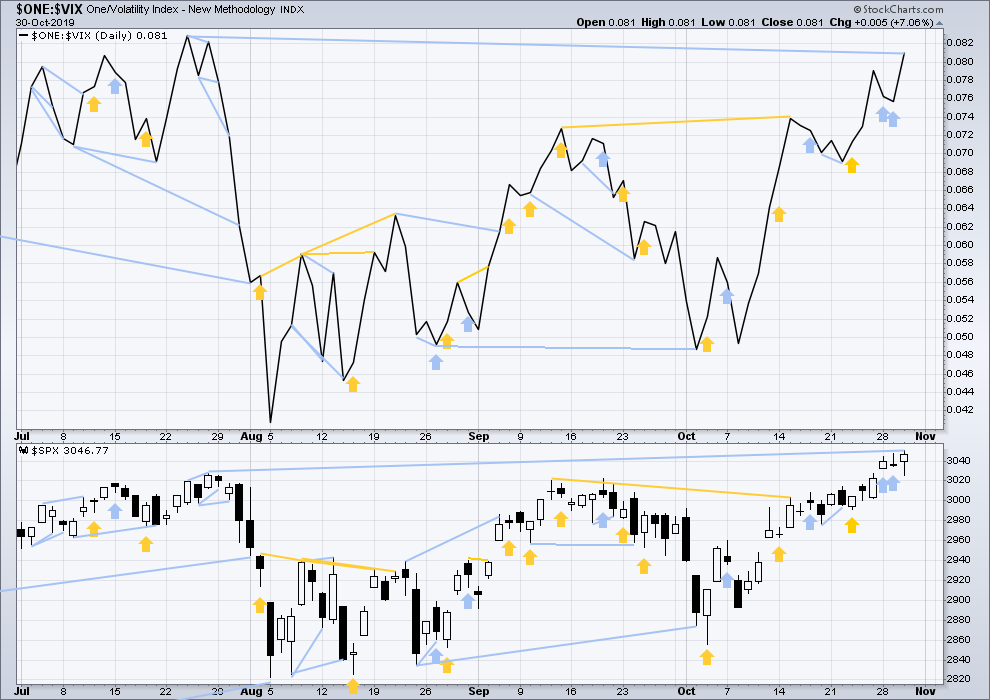
Click chart to enlarge. Chart courtesy of StockCharts.com. So that colour blind members are included, bearish signals
will be noted with blue and bullish signals with yellow.
Two bearish signals in a row from inverted VIX have now been followed by more upwards movement and another new all time high today from price. The bearish signals from VIX may be considered to have failed, but they may also be an early warning of a pullback to develop.
Today inverted VIX has moved higher with price. There is no new short-term divergence. However, there remains longer term and mid-term divergence as the new all time high from price has not been matched by a new all time high from inverted VIX.
DOW THEORY
Dow Theory confirmed a bear market in December 2018. This does not necessarily mean a bear market at Grand Super Cycle degree though; Dow Theory makes no comment on Elliott wave counts. On the 25th of August 2015 Dow Theory also confirmed a bear market. The Elliott wave count sees that as part of cycle wave II. After Dow Theory confirmation of a bear market in August 2015, price went on to make new all time highs and the bull market continued.
DJIA: 23,344.52 – a close on the 19th of December at 23,284.97 confirms a bear market.
DJT: 9,806.79 – price has closed below this point on the 13th of December.
S&P500: 2,532.69 – a close on the 19th of December at 2,506.96 provides support to a bear market conclusion.
Nasdaq: 6,630.67 – a close on the 19th of December at 6,618.86 provides support to a bear market conclusion.
With all the indices having moved higher following a Dow Theory bear market confirmation, Dow Theory would confirm a bull market if the following highs are made:
DJIA: 26,951.81 – a close above this point has been made on the 3rd of July 2019.
DJT: 11,623.58 – to date DJT has failed to confirm an ongoing bull market.
S&P500: 2,940.91 – a close above this point was made on the 29th of April 2019.
Nasdaq: 8,133.30 – a close above this point was made on the 26th of April 2019.
Published @ 06:58 p.m. EST.
—
Careful risk management protects your trading account(s).
Follow my two Golden Rules:
1. Always trade with stops.
2. Risk only 1-5% of equity on any one trade.
—
New updates to this analysis are in bold.

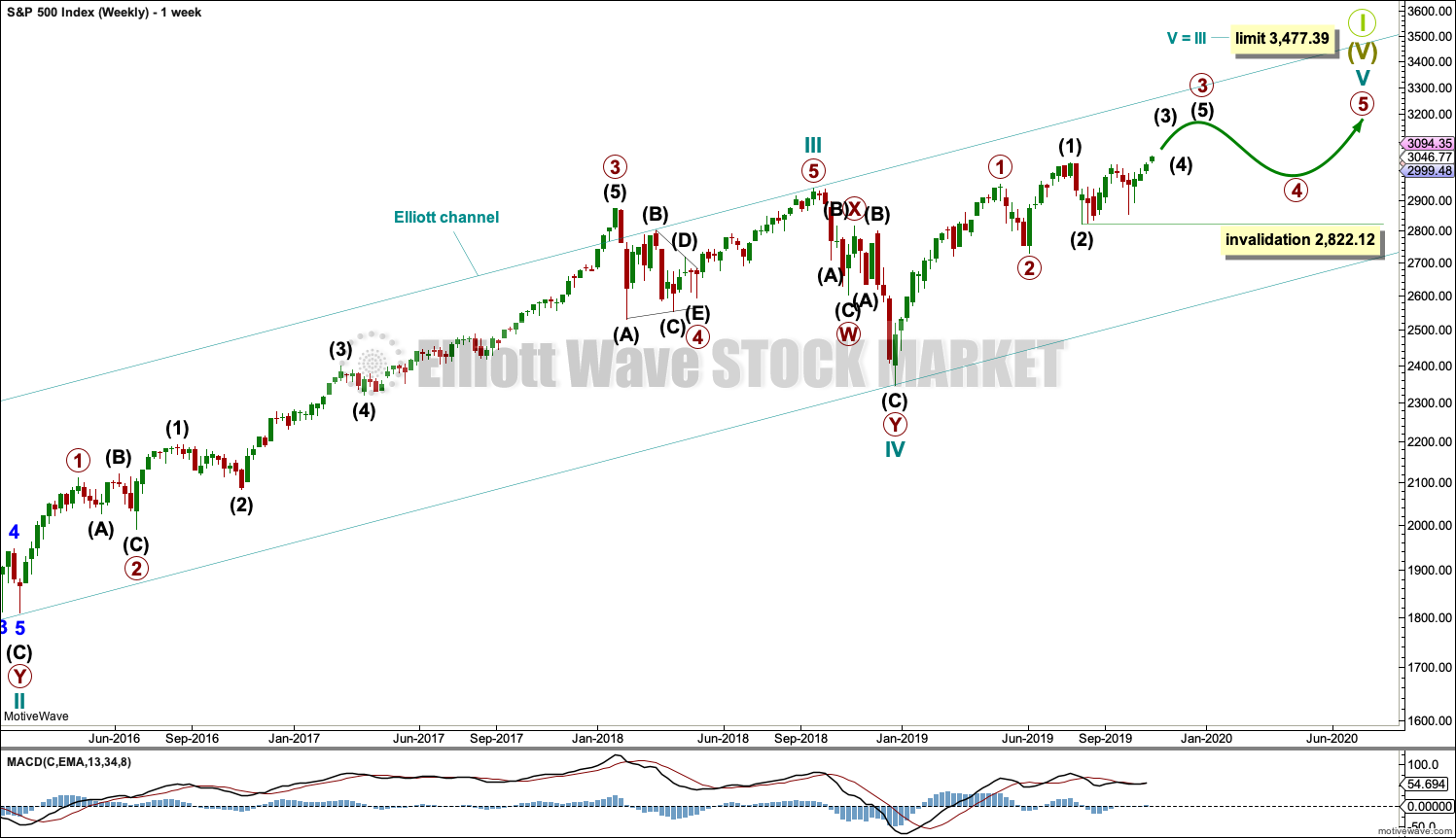
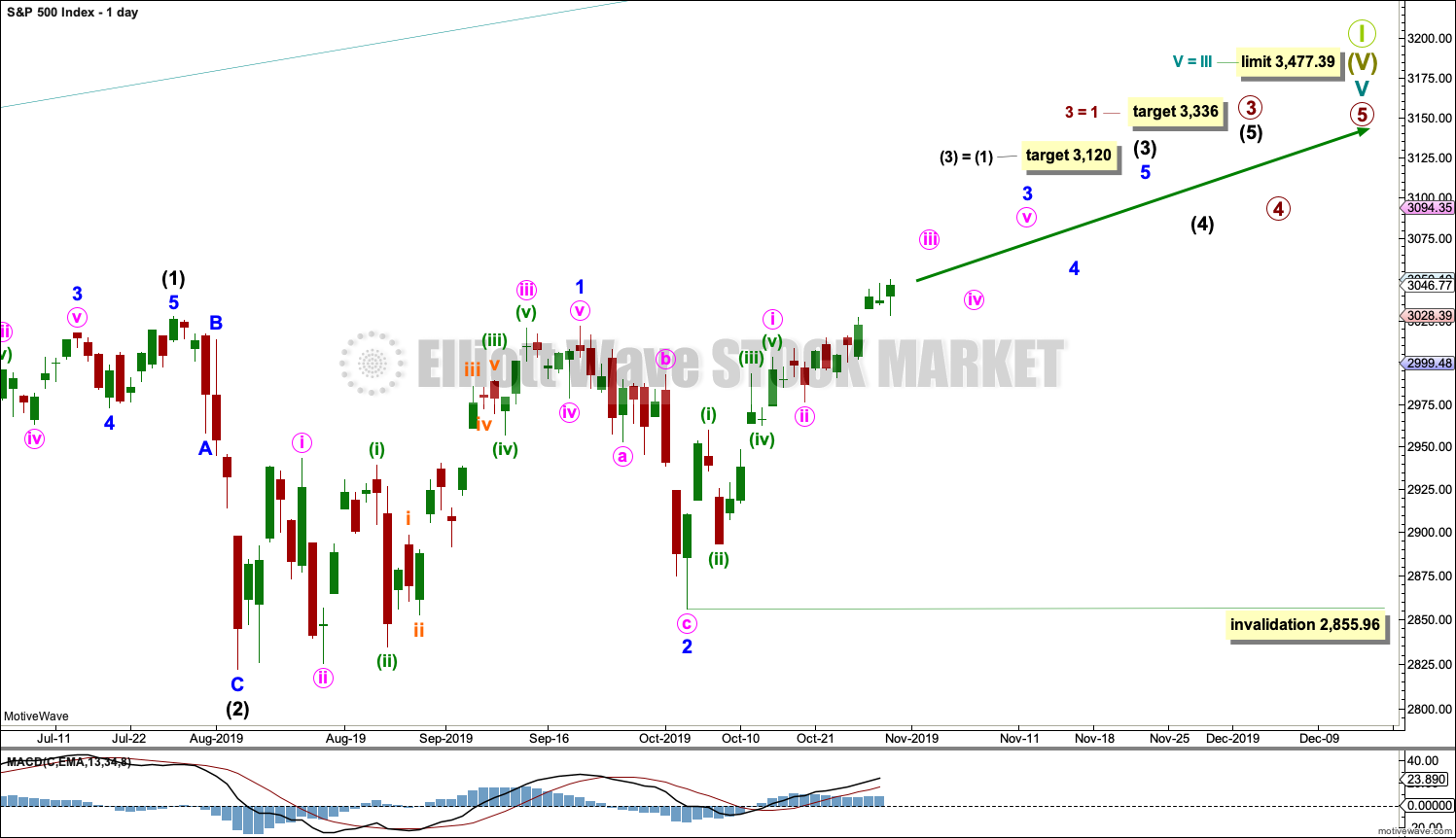
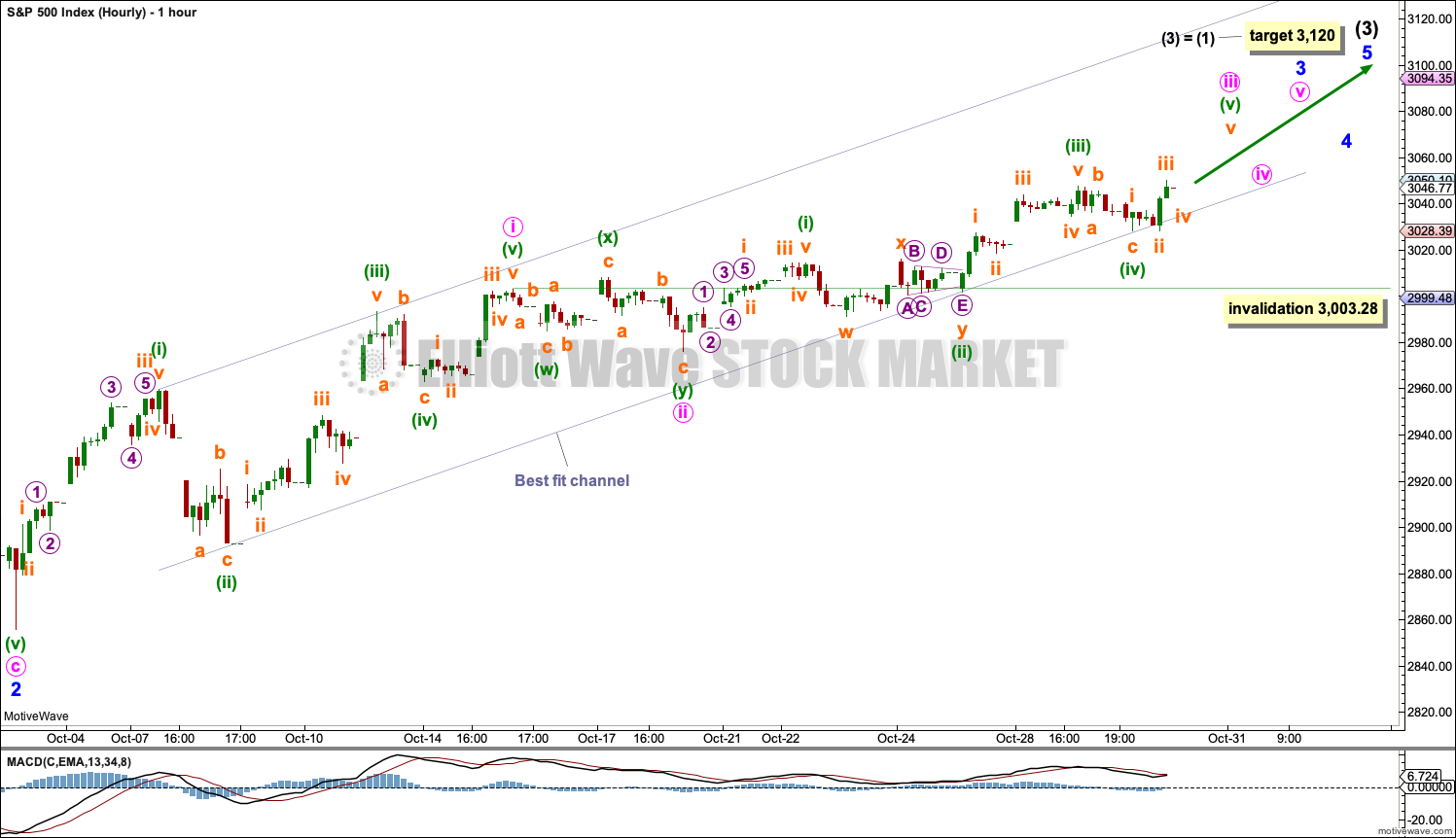
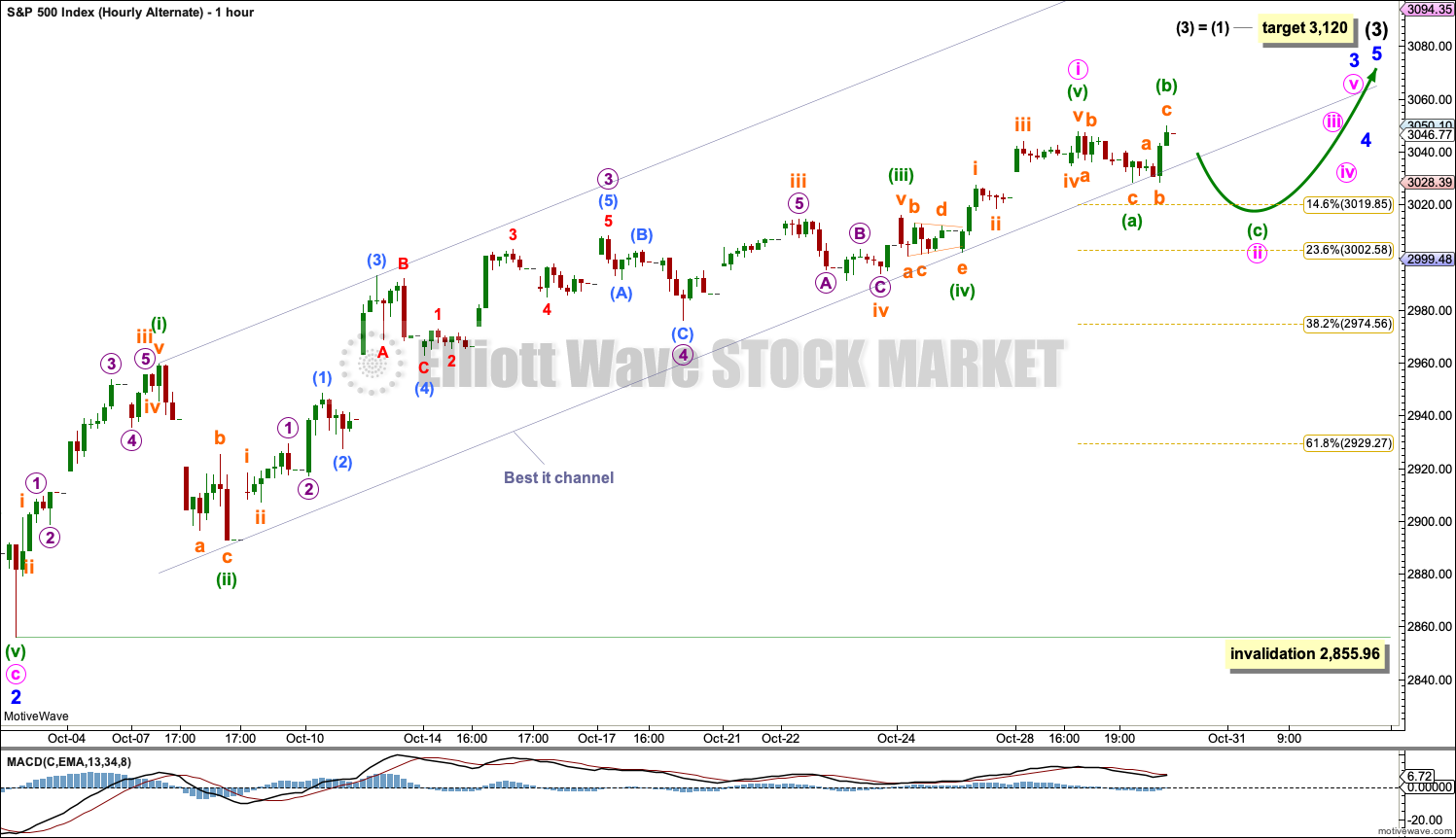
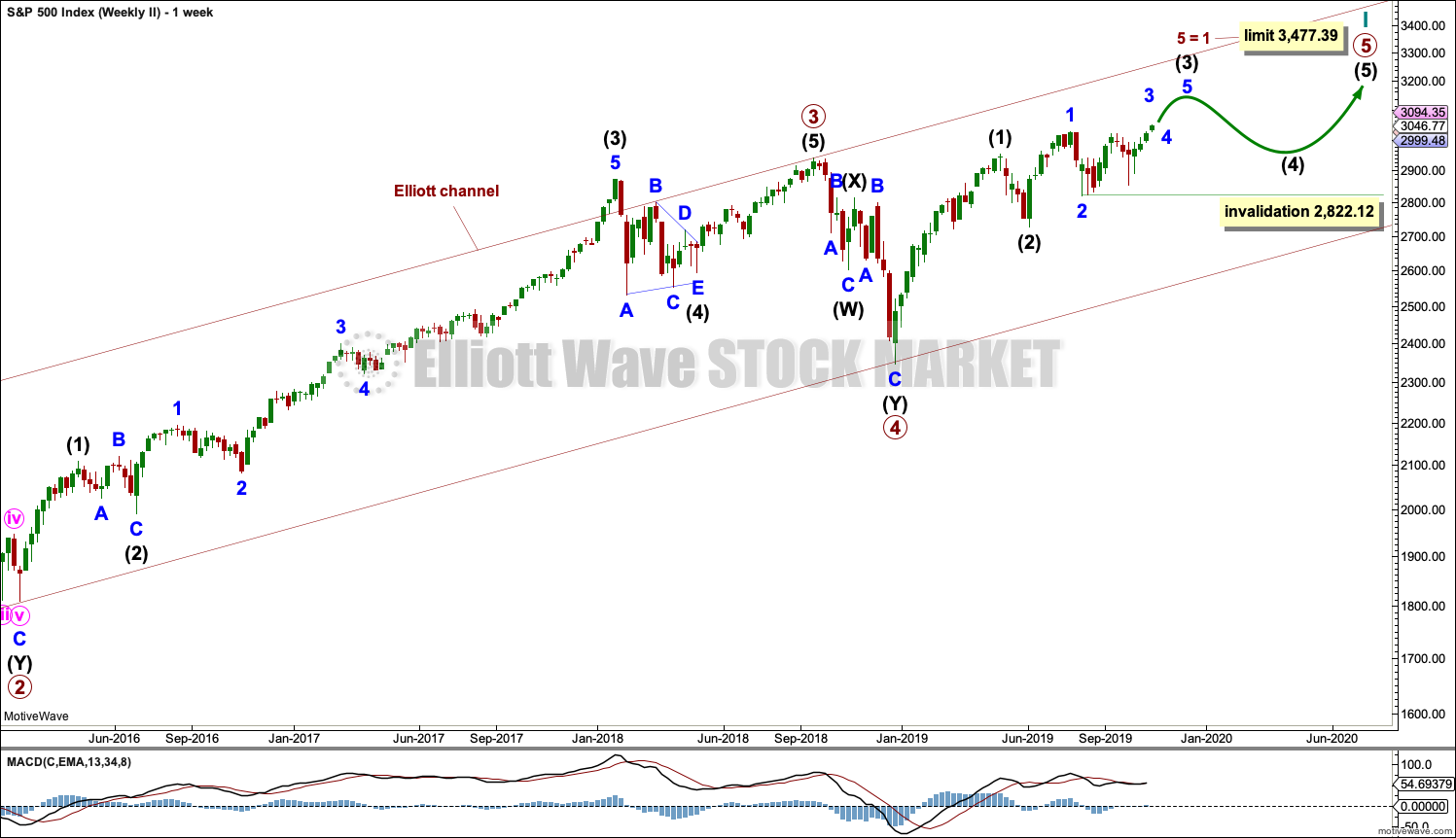
The pullback ended short of the target, support is now strong in that area
I’ll probably go today with only the first / main hourly chart as the alternate doesn’t have enough room above for the structure to complete before the target
main hourly updated:
alternate hourly updated
Hi Lara, do you mantain your principal chart?
SPX now @ 3065.
ToS back now…
Here’s my bullish model for RUT. It’s a model…not a prediction.
I put on a fresh ‘fly centered expiring tomorrow at 156 in IWM on the bet that that minuette iv is now complete (oh whoops, I used #’s and not small roman numerals in that count, my bad). Last 20 minutes of action is indicating it may very well be, but some more up in final 30 minutes would float that little boat. The heat forced me out of both my IWM and SPY ‘flys from yesterday (commission losses mostly) earlier in the day, per my plan. Heat -> exit on these short term butterflies.
I also closed a bunch of profitable sold put spreads, to generally lighten my exposure given the increased risk of a moderate correction just starting to develop here. Gotta stay “in rhythm” with the market.
I’m seeing a bear flag on the hourly chart :-/
Also a bearish engulfing candle on the ES chart.
Not to mention TLT is busting upwards…
Other Ameritrade/Thinkorswim users dead this morning? Seemed to go about 10:25am EDT. I’ve shut down and restarted but no data on anything. Meanwhile my IB platform is running just fine. Gack.
Working well on my phone (Android). Didn’t experience any issue today
Being down 19 SPX points, it seems to me that the Alternate Hourly wave count fits best. We would now be in Minuette C of Minute ii with a downside target of 3020 to 3000.
Happy Halloween.
Why can’t warlocks have babies? Because they have hallow weenies!
Hey…I resemble that remark!!
BTW, why did the punk rocker cross the road???????
wait for it
wait for it….
because he had a chicken stapled to his face.
Ha. Ha. Ha.
And didja hear about the cross eyed school teacher who couldn’t control her pupils?
Stop me now! (Slow market day…)
Chuckle. Chuckle. Thanks
Hey, hey, Yogi bear. You must be out camping in Jellystone Park.
Another ATH, both intraday and closing. As said previously, Surprises should be to the upside.
When we get to this 3120 are we looking for further upside ?
3120 is the projection for the completion of the minor 3. So a minor 4 is expected there. After that…more upside.
Dontcha know bears like baseball??? What a game 7!!
not so fast. Bear like football. Cubs like baseball. Notice I did not say the Bears can play football. But they like it.